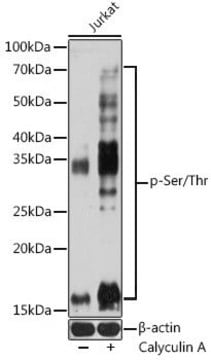MABF2811
Anti-Hemagglutinin Antibody, Influenza A virus H5N8 Antibody, clone 7H6C
Synonym(s):
HA-H5N8
About This Item
Recommended Products
biological source
mouse
Quality Level
antibody form
purified antibody
antibody product type
primary antibodies
clone
7H6C, monoclonal
mol wt
calculated mol wt 64.61 kDa
observed mol wt ~60 kDa
purified by
using protein G
species reactivity
virus
packaging
antibody small pack of 100 μL
technique(s)
affinity binding assay: suitable
immunofluorescence: suitable
western blot: suitable
isotype
IgG1κ
epitope sequence
N-terminal half
Protein ID accession no.
UniProt accession no.
storage temp.
2-8°C
Gene Information
vaccinia virus ... HA(3654615)
General description
Specificity
Immunogen
Application
Evaluated by Western Blotting with full-length, recombinant Hemagglutinin HA from the H5N8 strain of Avian influenza A virus.
Western Blotting Analysis (WB): A 1:500 dilution of this antibody detected full-length, recombinant Hemagglutinin HA from the H5N8 strain of Avian influenza A virus, but not the recombinant Hemagglutinin HA2.
Tested applications
Inhibition: A representative lot inhibited Hemagglutinin activity in Influenza A virus H5N8 in (Cheng, Y-C. and Chang, SC. (2021). Appl Microbiol Biotechnol. 105(1); 235-245).
Electron Microscopy: 45 g/mL from a representative lot detected Hemagglutinin, Influenza A virus H5N8 in H5/H6/H7 trivalent VLPs. (Data provided by Dr. Hui-Wen Chen (Department of Veterinary Medicine, National Taiwan University).
Immunofluorescence Analysis: 4.5 µg/mL from a representative lot detected Hemagglutinin, Influenza A virus H5N8 in Recombinant baculovirus-infected Sf21 cells (Data provided by Dr. Hui-Wen Chen (Department of Veterinary Medicine, National Taiwan University).
Western Blotting Analysis: A representative lot detected Hemagglutinin, Influenza A virus H5N8 in Western Blotting applications (Cheng, Y-C., and Chang, SC. (2021). Appl Microbiol Biotechnol. 105(1); 235-245).
Affinity Binding Assay: A representative lot detected Hemagglutinin, Influenza A virus H5N8 in Affinity Binding applications (Cheng, Y-C., and Chang, SC. (2021). Appl Microbiol Biotechnol. 105(1;235-245).
ELISA Analysis: A representative lot detected Hemagglutinin, Influenza A virus H5N8 in ELISA applications (Cheng, Y-C., and Chang, SC. (2021). Appl Microbiol Biotechnol. 105(1); 235-245).
Note: Actual optimal working dilutions must be determined by end user as specimens, and experimental conditions may vary with the end user.
Physical form
Storage and Stability
Other Notes
Disclaimer
Not finding the right product?
Try our Product Selector Tool.
Storage Class Code
13 - Non Combustible Solids
WGK
WGK 1
Flash Point(F)
Not applicable
Flash Point(C)
Not applicable
Certificates of Analysis (COA)
Search for Certificates of Analysis (COA) by entering the products Lot/Batch Number. Lot and Batch Numbers can be found on a product’s label following the words ‘Lot’ or ‘Batch’.
Already Own This Product?
Find documentation for the products that you have recently purchased in the Document Library.
Our team of scientists has experience in all areas of research including Life Science, Material Science, Chemical Synthesis, Chromatography, Analytical and many others.
Contact Technical Service








